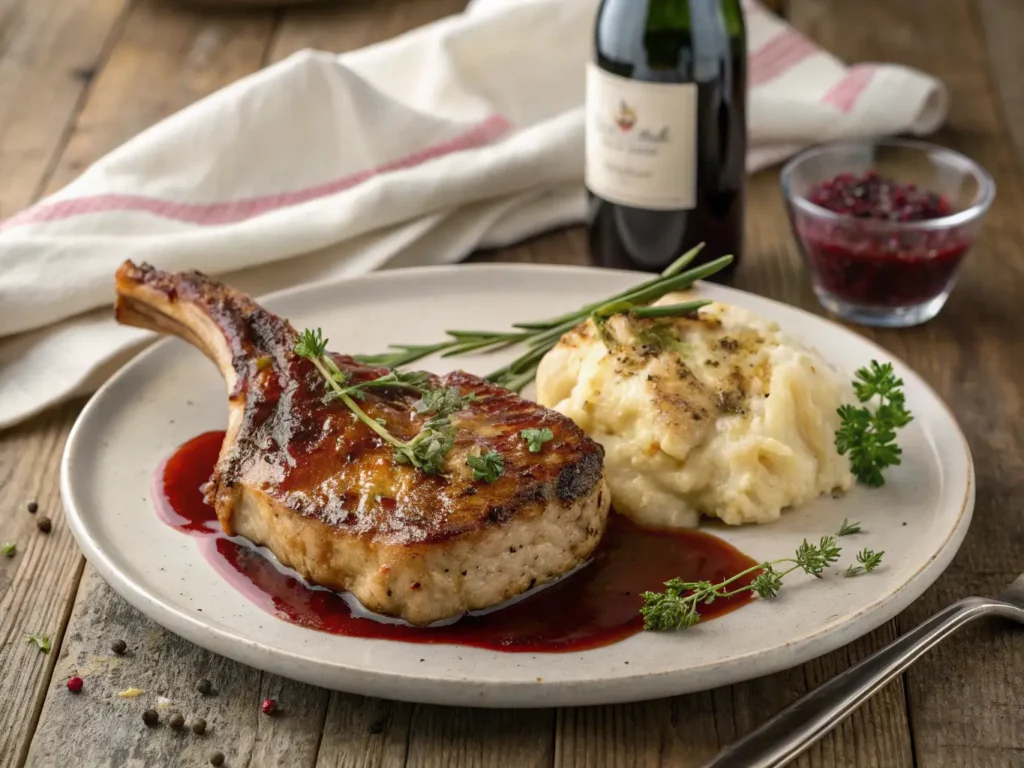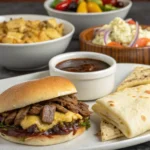If you’re looking to elevate your next dinner with something truly rich and memorable, the Berkshire pork chop is where you start. Known for its deep marbling, juicy tenderness, and robust pork flavor, this cut comes from heritage breed Berkshire pigs a far cry from your average grocery store pork.
Often called the “Wagyu of pork,” Berkshire pork delivers a gourmet level experience whether you’re grilling, pan searing, or roasting. It’s beloved by chefs and food lovers for its naturally rich flavor and melt in your mouth texture.
In this guide, you’ll learn:
- What makes Berkshire pork chops different
- The essential ingredients to let the meat shine
- Chef Lucas Benette’s tips for cooking it perfectly
- Step by step instructions and cooking temps
- A table of cuts and doneness levels
- FAQs for sourcing, storing, and serving this premium meat
Let’s start by understanding why this cut is so special.
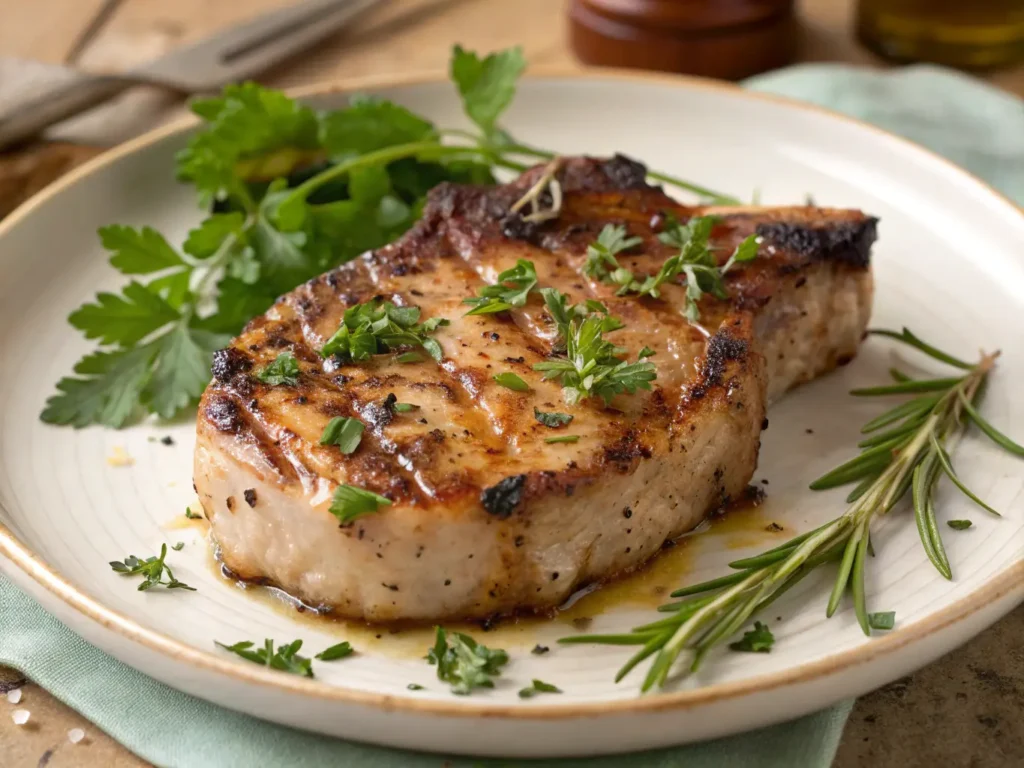
What Makes a Berkshire Pork Chop Different?
Berkshire pigs are an English heritage breed prized for their flavorful meat and generous fat marbling. Unlike standard commercial pork which is bred to be lean Berkshire pork is known for being:
Rich in Marbling
This intramuscular fat melts during cooking, keeping the meat juicy and tender without needing brines or heavy sauces.
Full of Flavor
The taste is noticeably deeper, nuttier, and more complex than conventional pork. It can stand up to simple seasoning or shine in high end recipes.
Perfect for High Heat Cooking
Whether you’re using a cast iron skillet or open grill, Berkshire pork holds its shape and caramelizes beautifully, thanks to its natural fat content.
Ingredients You’ll Need
When cooking a Berkshire pork chop, less is more. The goal is to enhance not mask the meat’s deep, buttery flavor. A few simple ingredients will help you do just that.
Main Ingredients:
- 1–2 Berkshire pork chops (bone in or boneless, about 1″ thick)
- Kosher salt
- Freshly ground black pepper
- 1 tbsp olive oil or neutral oil with a high smoke point
- 1 tbsp unsalted butter (for basting)
- 2 cloves garlic, smashed
- 1–2 sprigs fresh rosemary or thyme
Optional Sides and Garnishes:
- Mashed potatoes, roasted vegetables, or creamy polenta
- Apple chutney or a light mustard sauce
- Lemon wedges for brightness
- Flaky sea salt for finishing
Ingredient Notes:
- Use coarse kosher salt for better crust development
- For extra tenderness, season the pork 30–60 minutes in advance and let it rest at room temperature before cooking
- A bone in chop offers more flavor and juiciness, while boneless is faster to cook
Tip: Avoid marinades with sugar when pan searing, as they can burn. Stick to dry seasoning or add sauce after cooking.
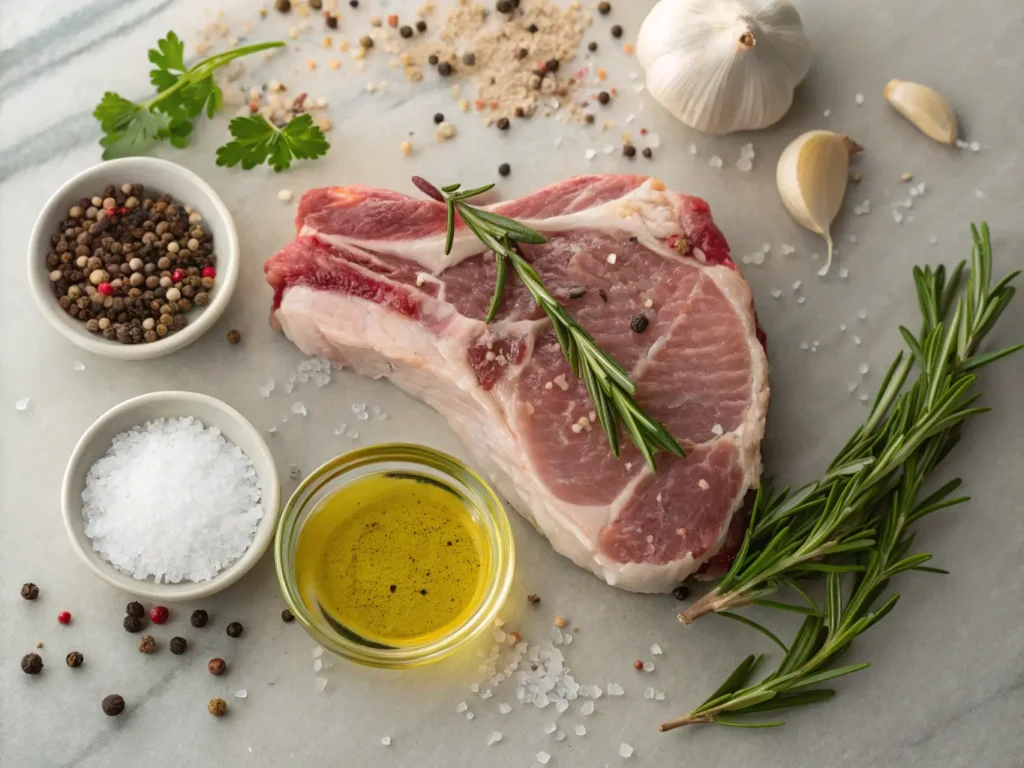
Chef Lucas Benette’s Method for Juicy, Perfect Pork Chops
Known for his attention to detail and passion for premium cuts, Chef Lucas Benette believes cooking a Berkshire pork chop is all about timing, technique, and temperature. Here’s how he brings out the best in this heritage meat.
1. Start with Room Temperature Chops
“Let the chop sit out for 30 minutes before cooking,” Lucas advises.
This ensures even cooking from edge to center and a more reliable sear.
2. Season Generously, Then Rest
“I salt the chop 30 minutes ahead just like a dry brine.”
This draws moisture to the surface and helps build a beautiful crust.
3. Sear in a Hot Cast Iron Skillet
Lucas heats a cast iron skillet over medium high heat with olive oil, then adds the chop:
- 2–3 minutes per side, undisturbed, for a deep golden crust
- Add butter, smashed garlic, and herbs during the last minute
- Tilt the pan and baste with the melted butter to lock in flavor
4. Finish to Temperature
Depending on thickness, either finish the chop:
- In the skillet (lower heat), flipping occasionally, or
- In a 375°F oven for 5–10 minutes for thicker, bone in chops
“Pull it at 140–145°F, then rest for 5–7 minutes to let juices redistribute.”
5. Slice and Serve with Style
Chef Lucas rests the chop, then slices against the grain and finishes with:
- A pinch of flaky sea salt
- A spoonful of pan drippings
- A side of bright herbs or sauce
Step by Step Cooking Instructions
Cooking a Berkshire pork chop at home doesn’t require restaurant tools just a hot pan, basic seasoning, and attention to timing. Follow this guide for a crispy crust, juicy center, and full flavor.
How to Cook a Berkshire Pork Chop (Pan + Oven Method)
Ingredients:
- 1 Berkshire pork chop (1″–1.5″ thick, bone in or boneless)
- Salt and pepper
- 1 tbsp olive oil
- 1 tbsp butter
- 2 garlic cloves, smashed
- 1 sprig rosemary or thyme
Step by Step:
1. Prep the pork chop
- Pat dry with paper towels
- Season generously with salt and pepper on all sides
- Let rest at room temperature for 30 minutes
2. Preheat your pan
- Heat a cast iron skillet over medium high heat
- Add olive oil and swirl to coat
3. Sear the chop
- Place chop in hot pan
- Sear 2–3 minutes per side without moving
- You’re looking for a deep, golden brown crust
4. Baste and add aromatics
- Lower heat slightly
- Add butter, garlic, and herbs to the pan
- Tilt pan and spoon butter over the chop for 1–2 minutes
5. Optional: Transfer to oven
- For chops over 1″ thick, move the pan to a preheated 375°F oven
- Roast for 5–10 minutes, or until internal temp reaches 140–145°F
6. Rest and serve
- Remove from pan
- Let rest on a plate, loosely tented with foil, for 5–7 minutes
- Slice and serve with sides of your choice
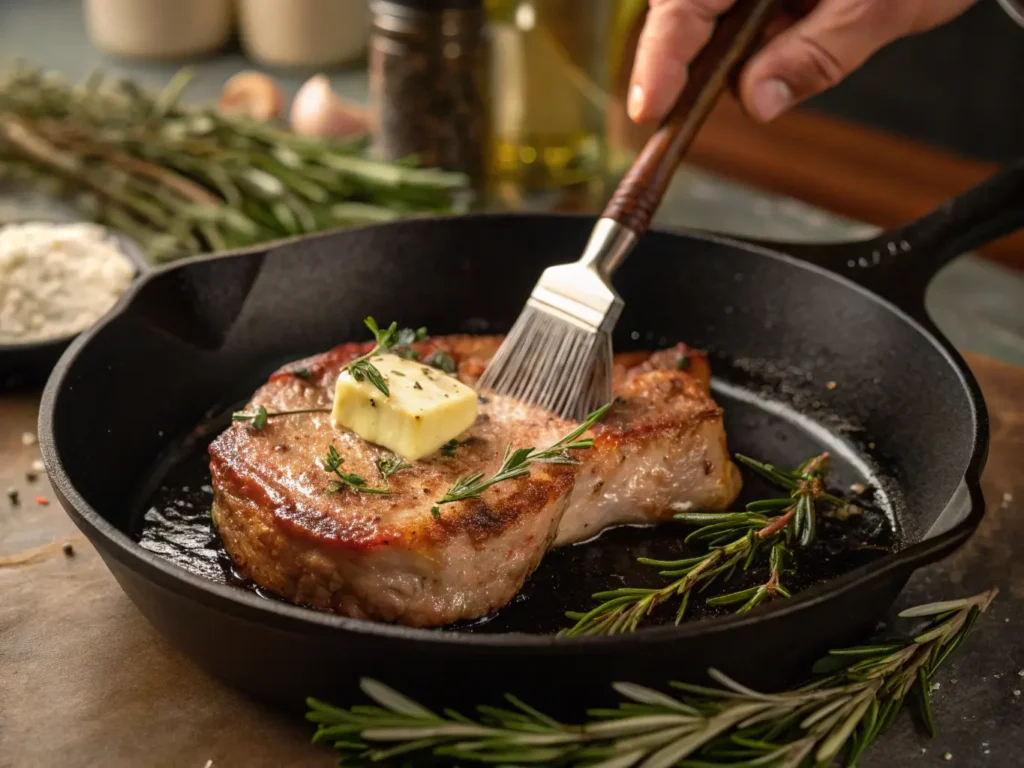
No thermometer? Gently press the chop it should feel firm but springy, not hard. Let it rest before slicing to retain juiciness.
Berkshire Pork Cut & Cooking Temp Table
Not all pork chops are created equal especially when it comes to Berkshire pork. Depending on the cut and thickness, cooking times and methods will vary slightly. Use this table to get perfect results every time.
Cut & Temp Guide
| Cut Type | Ideal Internal Temp | Recommended Method | Cooking Tip |
|---|---|---|---|
| Bone in chop | 145°F (medium) | Sear + finish in oven | Adds flavor and stays juicier near the bone |
| Boneless chop | 140–145°F | Quick stovetop sear | Cooks faster rest immediately after cooking |
| Tomahawk chop | 145°F + 5 min rest | Reverse sear or indirect grilling | Use a meat thermometer for accuracy |
Pro Tip: Always let your chop rest 5–7 minutes after cooking. This allows the juices to redistribute and keeps the meat moist when sliced.
Bonus Flavor Enhancers:
- Compound butter (with garlic and herbs) for finishing
- Pan sauce with a splash of white wine or balsamic
- Apple or pear chutney for a classic sweet and savory pairing
- Grainy mustard glaze for an elevated finish
FAQs About Berkshire Pork Chops
1. What’s the difference between Berkshire pork and regular pork?
Berkshire pork comes from a heritage breed of pig known for its rich marbling, deep flavor, and tender texture. Unlike regular pork often lean and mild in flavor Berkshire pork is juicier, more flavorful, and naturally more tender, thanks to higher intramuscular fat and better genetics.
2. What makes Berkshire pork so special?
Berkshire pork is prized for its high quality fat, deep reddish pink color, and buttery texture. It’s often called the “Wagyu of pork” because of its marbling and melt in your mouth richness. The pigs are usually raised more humanely and on better diets, which enhances both taste and texture.
3. Why is Berkshire pork so expensive?
The higher price comes from a combination of factors:
- Heritage breed rarity
- Slower growth cycles
- Smaller scale farms
- Superior quality and taste
Because it’s not mass produced like commodity pork, Berkshire pork is more labor intensive to raise but the flavor and tenderness justify the cost for many chefs and home cooks.
4. What is another name for Berkshire pork?
Berkshire pork is also known as Kurobuta pork, which is the Japanese name for this breed. In Japan, it’s considered a luxury meat, much like Kobe beef. Whether labeled Berkshire or Kurobuta, the pork comes from the same breed and delivers the same rich, premium experience.
Final Thoughts on This Premium Pork Chop
A Berkshire pork chop isn’t just another cut of meat it’s a gourmet experience. From its incredible marbling and tenderness to its deep, rich flavor, this heritage breed delivers restaurant quality results right from your kitchen.
With simple seasoning, a hot pan, and a few chef approved techniques, you can turn this premium cut into a centerpiece worthy meal any night of the week.
Pair it with:
- Roasted garlic mashed potatoes
- Charred asparagus or sautéed greens
- A dry rosé, pinot noir, or crisp cider
